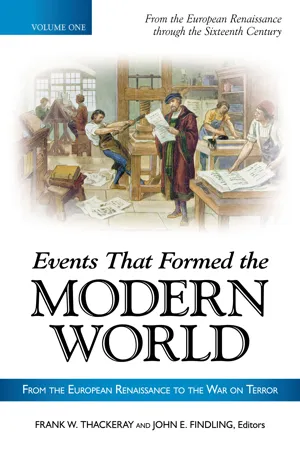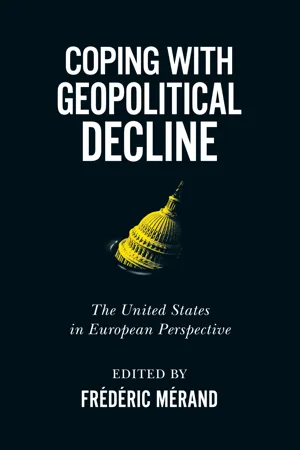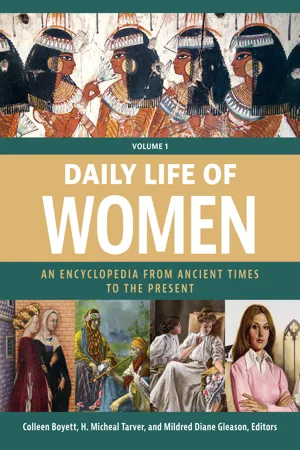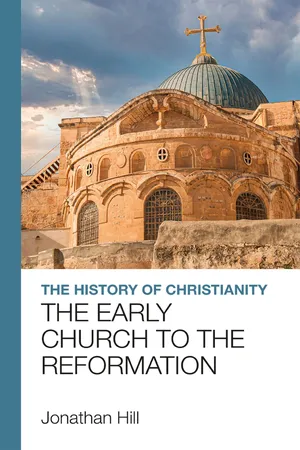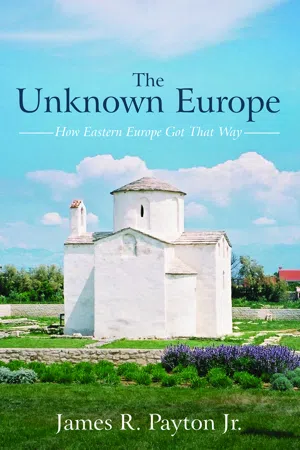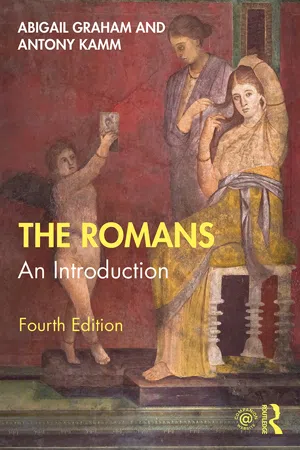History
Fall of the Byzantine Empire
The Fall of the Byzantine Empire refers to the conquest of Constantinople by the Ottoman Turks in 1453, marking the end of the Byzantine Empire. This event had significant implications for the balance of power in Europe and the Mediterranean region, leading to the spread of Renaissance ideas and the influx of Byzantine scholars and texts into Western Europe.
Written by Perlego with AI-assistance
Related key terms
10 Key excerpts on "Fall of the Byzantine Empire"
- eBook - ePub
Events That Formed the Modern World
From the European Renaissance through the War on Terror [5 volumes]
- Frank W. Thackeray, John E. Findling, Frank W. Thackeray, John E. Findling, Frank W. Thackeray, John E. Findling(Authors)
- 2012(Publication Date)
- ABC-CLIO(Publisher)
8 The Fall of Constantinople, 1453
Introduction
By 1453, the Byzantine Empire had shrunk to a mere shadow of its former self. It had dwindled to little more than its capital city—the wealthy and sophisticated Constantinople—and its environs. However, it had not always been like this. The Byzantine Empire, sometimes referred to as the Eastern Roman Empire, was the direct lineal heir of antiquity’s fabled Roman Empire. For centuries it had continued many of the Roman Empire’s traditions in a cosmopolitan, prosperous, energetic atmosphere. The Byzantine Empire at its height included most of the Balkans and Asia Minor (Anatolia), and it dominated the eastern Mediterranean Sea. Constantinople, named after the famous Roman emperor Constantine, sat astride several of the world’s great commercial routes. From its location on the western shore of the Bosporus (the narrow strait along with the Sea of Marmara and the Dardanelles that separates Europe from Asia), Constantinople handled trade from China and the Far East, the Middle East, western Europe, Egypt, and Russia.In the thousand years before its fall, the Byzantine Empire had experienced several periods of decline followed by recovery. One of these periodic recoveries occurred under the auspices of a ruling dynasty called the Macedonians (867–1081). However, as the Macedonian dynasty grew weak, several problems arose that in the long run proved fatal to the empire. In the Balkans, indigenous people such as the Bulgars and the Serbs resisted Byzantine overlordship. At the same time, the empire’s economic and military base also deteriorated. By the eleventh century, large, aristocratic estates were absorbing the free Anatolian peasantry (who provided the manpower for the empire’s army and the taxes for its treasury) and turning these peasants into serfs. Furthermore, energetic Italian city-states such as Genoa and, especially, Venice began to chip away at the Byzantine Empire’s commercial domination of the eastern Mediterranean. Trade concessions followed, and a weakened empire even devalued its currency for the first time in centuries. - eBook - ePub
A History of Europe
From 1378 to 1494
- W.T. Waugh(Author)
- 2016(Publication Date)
- Routledge(Publisher)
CHAPTER XVIIITHE Fall of the Byzantine Empire AND THE TURKISH CONQUEST OF THE BALKAN PENINSULA
T HE capture of Constantinople by the Turks is I one of the most famous catastrophes in history. And it is probable that more important consequences have been erroneously ascribed to it than to any other historical event. It is true that it caused a great shock to the whole of Christendom; but it made very little difference to the relations or prospects of the states of Europe. And though the circumstances attending the fall of the great city lent the catastrophe a certain tragic dignity, the events which led up to it arouse little admiration for any of those concerned. The history of the Balkan Peninsula during the last century of the Middle Ages can scarcely be matched for folly, treachery and cruelty. There was, as we have seen, no lack of brutality and rapine in western and central Europe in those days; but the wars of France or Germany seem chivalrous and humane when compared with the contemporary conflicts of south-eastern Europe. Here and there gleams of heroism relieve the gloom; but too often one finds that the hero is no more than a brave blackguard. Why any of the peoples involved care to dwell on their doings in this period is incomprehensible.The Byzantine Empire in the first part of the fourteenth centuryThe Byzantine Empire had been a magnificent state, and had rendered eminent services to the cause of European civilization, both by the example of its own life and also by its resistance—for long successful—to barbarian or Moslem invaders. But it had been well for its renown if it had never revived after its overthrow by the Fourth Crusade in 1204. For it was never again anything but a quaking ruin, dependent for its continuance more upon the weakness or dissension of its foes than upon its own courage or merits. In the first part of the fourteenth century it held little more on the European mainland than the province of Rumelia—or eastern Thrace—the peninsula of Chalcidice, the city of Salonica, and a small part of the Morea, while in Asia it possessed but a few square miles of land on the shores of the Bosphorus and the Sea of Marmora, together with one or two cities. Its European territories were constantly threatened and often cut short by the Bulgarians and the Serbians, who successively established powerful empires. Central and southern Greece were for the most part under rulers of western origin, Catholic in religion. The republic of Venice had occupied various points on the coast, and many of the Ionian and Ægean islands were held by her or Genoa. And in Asia Minor the Empire was confronted with the rapidly growing power of the Ottoman Turks, who had possessed the ascendancy over their rivals, Christian or Moslem, since the closing years of the previous century. Europeans frequently think of these Turks as though they were ill-disciplined barbarians, formidable through their numbers and ferocity. In reality, the Turkish army had no superior in training, organization, and equipment, and Turkish generalship was quite as good as any with which it was likely to be called upon to cope. - eBook - ePub
Coping with Geopolitical Decline
The United States in European Perspective
- Frédéric Mérand, Frédéric Mérand(Authors)
- 2020(Publication Date)
- McGill-Queen's University Press(Publisher)
The Culture of Decline in Later Byzantium Cecily Hilsdale THE BYZANTINE EMPIRE AND THE PERIODIZATION OF ITS DECLINEAt least since Edward Gibbon, decline has been inevitably associated with fall. Given Gibbon’s focus on the ancient Roman Empire, “New Rome” or Byzantium figures as an empire destined for demise. The later Byzantine period especially is treated as a failed moral, political, and military empire. Chapters 61–8 of his magisterial work cover the period from 1204 to 1453 – that is, from the conquest of Constantinople by the Franks of the Fourth Crusade (1204) to the final conquest of the imperial capital by the Ottomans (1453). The fact that these events are taken most frequently as the main chronological markers of the later Byzantine period is instructive in its own right. How could this period be understood as anything but tragic when bracketed by two cataclysmic moments of destruction and devastation? With its status as final and fleeting, Gibbon understands the later eastern and Christian continuation of ancient Rome as the eve of the empire’s end.1All too often publications devoted to this later Byzantine period, especially art-historical studies, invoke environmental and organic metaphors to encapsulate the mood of immanent ending, and in so doing they suggest that history follows the laws of nature in its cyclical teleology. Title phrases such as the “twilight” of Byzantium, for example, evoke the coming darkness of night; the “final flowering” of culture in this period alludes to the inevitable wilting and decay that prompts a return to primordial earth. - eBook - ePub
Daily Life of Women
An Encyclopedia from Ancient Times to the Present [3 volumes]
- Colleen Boyett, H. Micheal Tarver, Mildred Diane Gleason, Colleen Boyett, H. Micheal Tarver, Mildred Diane Gleason(Authors)
- 2020(Publication Date)
- Greenwood(Publisher)
The Byzantine Empire INTRODUCTION Byzantine history is a continuation of Roman history. The empire that we refer to as “Byzantine” today was called “Roman” by those who ruled and inhabited it. Roman political, social, and cultural institutions remained at work in the Byzantine Empire down to its fall in the fifteenth century. In the seventeenth century, scholars in the West began to refer to the period of Roman history after Constantine as something different, designating this “Byzantine,” a reference to Byzantion (Latin, Byzantium), which was the classical predecessor of Constantinople and often a synonym for it. This terminology was influenced by a well-established Western, anti-Byzantine bias, whose roots were in the medieval period, that viewed the West as superior. This terminology was useful in the attempt of these scholars to distance Byzantium from this Western heritage. Fortunately, historical study today has moved beyond medieval and early modern biases to recognize connections and continuities, something already apparent to astute observers in the past. The great eighteenth-century British historian Edward Gibbon, in his classic study, The Decline and Fall of the Roman Empire, told the story of the Roman Empire from its high point in the second century CE down to the fall of Constantinople in 1453. He well understood that this was all Roman history. Yet, the terms “Byzantine” and “Byzantium” have since generally been adopted by modern historians to denote the Christian empire that existed from the fourth to the fifteenth centuries CE in contrast to the pagan Roman Empire that preceded it. Still, it must be noted that the inhabitants of the Byzantine Empire always called themselves Rhomaioi, the Greek word for “Romans,” and even the Ottoman Turks called their Orthodox Christian subjects by the name that they called themselves, “Rum” (or “Roman”), until the early twentieth century - eBook - ePub
The Fall of Constantinople to the Ottomans
Context and Consequences
- Michael Angold(Author)
- 2014(Publication Date)
- Routledge(Publisher)
CHAPTER 1 The fall of Constantinople as a turning pointT he fall of Constantinople is a story that has often been told. It is Sir Steven Runciman who tells the story best in his Fall of Constantinople 1453, which is a consummate example of history as narrative, but even he was beginning to wonder whether the topic merited another book.1 He did not think that over the details of the siege he had much to add to the account given by Sir Edwin Pears in his Destruction of the Greek Empire, which originally appeared in 1903, the year of Runciman’s birth.2 Runciman’s hesitations have not prevented others from undertaking the retelling of the story of the fall of Constantinople. The most recent attempt by M. Philippides and W.K. Hanak is on a massive scale and provides a convincing and detailed reconstruction of the event.3 It is not my intention to provide yet another narrative or to attempt another reconstruction. The focus of my interest will be on the historical significance of the fall of Constantinople to the Ottomans. Was it one of history’s turning points? Such an approach will necessarily highlight its prehistory and its consequences, at the expense of the event itself. But it makes little sense to write about the fall of Constantinople without first providing a brief sketch of those desperate days in April and May 1453.IThe decision taken by the young Sultan Mehmed II (1451–81) to embark on the conquest of Constantinople represented the failure of political arrangements, which for fifty years had allowed Byzantium to survive and to a degree to prosper. He blamed the Byzantine emperor for the political crisis at the heart of the Ottoman ruling institution, which had overshadowed his boyhood. We are never going to know exactly what the forces were which in 1444 persuaded his father Murad II to abdicate in favour of his son, who was not quite thirteen.4 There are, however, pointers, such as rumours that the young Mehmed – or at least the men behind him – were agitating for an attack on Constantinople. There was deep suspicion of the Byzantine emperor, who was blamed for orchestrating a series of Hungarian invasions of the Ottoman Empire, which were only beaten off with great loss of life.5 Some at the Ottoman court were beginning to see an independent Constantinople as a threat to security. They also resented the ascendancy exercised over Murad II by his Grand Vezir Çandarli Halil Pasha, who was an advocate of entente with Byzantium. The conquest of Constantinople will no doubt have appealed to Mehmed II’s youthful bravado nurtured by reading about the exploits of Alexander the Great. Encouraging him was a clique at the Ottoman court, which in the search for preferment had attached itself to the young sultan. From the names that we have they seem to have been predominantly from Christian families, but converts to Islam brought up at the Ottoman court. They were slave administrators and represented a new political force, which emerged as an Ottoman central government began to take clearer shape. They had a vested interest in extending the effective authority of the sultan, but were frustrated by Murad II, who preferred to maintain the status quo, ably seconded by his Grand Vezir. His was always the voice of moderation. When in 1437 Sultan Murad II was contemplating a punitive expedition against Constantinople, there was one dissenting voice, that of Halil Pasha. He argued that any attack on Constantinople would throw the emperor into the arms of the Latins. It was better to let matters take their course, since the Ottomans had little to fear, protected as they were by a series of treaties.6 - eBook - ePub
The History of Christianity
The Early Church to the Reformation
- Jonathan Hill(Author)
- 2020(Publication Date)
- Lion Scholar(Publisher)
As the empire reached its greatest strength, it also began to decline. There were still wars with the various barbarians and, after the death of Basil II in 1025, they were no longer going so well for the Byzantines. This period saw the appearance of an alarming new enemy, too – the Seljuk Turks. These were a people from the East who had been associated with the Khazar empire, but in the middle of the eleventh century they moved west and south, conquering Baghdad and setting up their leader, Sultan Tughrul Bey, as protector of the Abbasid caliphate. They then moved against Armenia, at that time ruled by the Byzantines, and conquered it without difficulty in the 1060s. The crunch came at the battle of Manzikert of 1071, when the emperor Romanus IV Diogenes was captured and forced to hand over large areas of land and pay a considerable ransom. By a nasty coincidence, the same year saw the loss of the Byzantine territory in Italy to the Normans. Byzantium was plunged into civil war as the disgraced Romanus, upon his return to the capital, was dethroned, blinded and thrown into a monastery to die. His successors refused to honour the treaty he had made with the Seljuks, with the inevitable consequence that the Turks advanced remorselessly into Byzantine territory, conquering half of Anatolia and setting up a new sultanate there, known as Rum (after the Arabian name for Rome), with (in a final indignity for the Byzantine church) Nicaea as its capital.Worse than this – if such a thing could be imagined – was the appalling Fourth Crusade. We shall see more of the crusades in Chapter 7, but this military expedition was ordered by Pope Innocent III against the Muslims who were holding the Holy Land. However, the crusaders lacked the money to get there, and so they were persuaded by Venetian businessmen to attack Constantinople instead. This they did in 1204, conquering the previously impregnable city and pillaging it mercilessly for three days. Forced to produce a justification after the event, the pope declared that the Byzantines had deserved it because they were schismatics. Baldwin of Flanders was crowned as the new Latin king of Constantinople. The surviving inhabitants of the city fled, and no fewer than three governments in exile were formed. The main one was at Nicaea, under the emperor Theodore Lascaris, where a new ecumenical patriarchate in exile was also set up. Back in Constantinople, a Venetian had been installed as the new Latin patriarch of the city, and attempts were made to put the Byzantine church firmly under the papal heel. One Cardinal Pelagius made himself exceptionally unpopular by persecuting all those who did not accept the supremacy of the pope or use only Latin rites in church. - eBook - ePub
- Timothy E. Gregory(Author)
- 2011(Publication Date)
- Wiley-Blackwell(Publisher)
In recent years, many historians have come to look at the events of the latter half of the sixth century in rather different ways. One approach has sought to view the changes in this period as based on the most fundamental units of society. Thus, scholars such as Alexander Kazhdan have argued that this period witnessed a collapse in the broader city-based or state-based social groupings, which resulted in the identification of individuals with small units such as the family. This change led to the significant weakening of the state. Other scholars have pointed to environmental changes, including the alleged (not fully proven) desertification of much of the southeastern rim of the Byzantine Empire, which had once been a primary producer of grain and other goods and which now became desert. Others look to more practical administrative and military matters, pointing out that the Byzantine state in the late sixth century did not have in place workable institutions for the recruitment and integration of troops, the result being the growing ineffectiveness of the Byzantine army and its inability to defeat the very different enemies who appeared from time to time.On the one hand, the question of why the Byzantine Empire went, in the span of 50 to 100 years, from being the dominant power (economically, culturally, and militarily) in the Mediterranean area to one whose very existence was in question is simply too difficult for historians to answer in a simplistic manner. Certainly, the combination of civil war, religious dissension, and ineffective leadership had important ramifications. On the other hand, the general condition of the empire and the nature of its enemies (at least until the rise of Islam) had not changed greatly. It is attractive for many to turn to explanations outside the control of human affairs – such as earthquakes, plagues, or even climatic or environmental change. These “explanations” are often favored simply because they are more or less mechanistic and do not necessarily require human intervention (or blame). Nonetheless, attractive as such theories are, the evidence to support them is not, to date at least, very convincing. This is not to say that such disasters did not occur – they certainly did – but just as with the invasions of the period, they had happened before, and the question really concerns whether the empire was able to deal with them. - eBook - ePub
The Unknown Europe
How Eastern Europe Got That Way
- James R. Payton(Author)
- 2021(Publication Date)
- Cascade Books(Publisher)
chapter 3A Bird’s Eye View, from Byzantium to Bosnia
“In this region of the world, we have too much history.”19This chapter offers an overview of the history of Eastern Europe,20 to serve as a foundation for more detailed treatments in following chapters on specific events that have significantly shaped that history. Along the way here, we will connect elements in this overview with those from the history of Western Europe with which readers are more familiar, to show similarities and differences in how the histories of the two segments of Europe unfolded. This will invite reflection on some questions about us who live in the West and about the study of history as we have focused and practiced it—all as a way to prepare for learning about the history of Eastern Europe.The Byzantine FoundationIn considering the history of Eastern Europe, we must begin with Byzantium, since it had enormous impact on the development of the nations and cultures of so much of the region—especially among the East and the South Slavs, but also (initially and despite interruption) among the West Slavs.21 Typically, we in the West pay almost no attention in our schooling to Byzantium, its empire, or its civilization.22 The historical focus in western education for the period when the Byzantine Empire existed (from 330 to 1453 ) has been on the collapse of the Roman Empire in the west and the ensuing chaos in Western Europe, and then on what we call the “medieval” period—the “middle” ages, between the ancient Greco-Roman civilization and the advent of the Renaissance and Reformation. This is understandable: what took place in Western Europe during this lengthy period has profoundly shaped that western civilization that Western Europe and North America share. In studying medieval Western Europe, we in the West are studying our own roots.However, this virtually exclusive preoccupation with medieval Western Europe may skew our perceptions of relative significance. While what took place in the millennial period between the destruction of the Roman Empire in the west and the dawning of early modern Europe significantly molded the civilization in which we live, if we infer that what was going on in Western Europe was the pinnacle of human accomplishment in that timespan, we are profoundly mistaken. For almost the whole of the Middle Ages, Western Europe was “small potatoes,” its accomplishments dwarfed by the much more sophisticated achievements of Byzantium.23 - eBook - ePub
- George Finlay(Author)
- 2018(Publication Date)
- Perennial Press(Publisher)
THE FALL OF THE BYZANTINE EMIRE ~ SECTION I THE REIGN OF ISAAC II (ANGELOS), A.D. 1185-1195. THE BYZANTINE EMPIRE WAS NOW hurrying rapidly to its end, and little is left to record except the progress of its dismemberment and destruction. The despotic power of the emperors was so firmly established, that every executive act emanated directly from the imperial cabinet. But, in perfecting this system of centralization, every tie of interest which had once attached the provincials to the imperial authority had been broken. The adhesion of the distant countries and various nations which composed the empire was destroyed; while, at the same time, the vital energy of the Greek population, which had grown to be the dominant race, was weakened by the immorality which, under the house of Comnenus, had spread through every rank of society. The defensive powers of the empire were consequently rapidly diminishing. The lavish expenditure of the imperial court impelled the government to carry its fiscal exactions so far, that the whole annual profits of the people’s industry were absorbed by taxation, and only the inferior classes of the cultivators of the soil and the day-labourers were able to retain the scanty surplus of wealth necessary to perpetuate their existence. Indeed, it is evident that encroachments were constantly made on the vested capital accumulated in past ages; and the funds appropriated in preceding times to uphold the most indispensable adjuncts of civilization were either annihilated or diverted from their destination. Ports, bridges, roads, aqueducts, and fortifications were seen falling to ruin in every province. Court spectacles and ecclesiastical ceremonies at the capital absorbed the funds which had been accumulated in distant municipalities for local improvements, hospitals, and schools - eBook - ePub
The Romans
An Introduction
- Abigail Graham, Antony Kamm(Authors)
- 2020(Publication Date)
- Routledge(Publisher)
11 The fall of the Roman Empire and its legacy: ad 330-PresentSome of the evidence (authors, events, historical figures and materials) discussed in this work are subjects of case studies on an accompanying webpage for this book. Look out for the companion website symbol.The decline of Rome was the natural and inevitable effect of immoderate greatness. Prosperity ripened to the principle of decay; the causes of destruction multiplied with the extent of conquest; and as soon as time or accident had removed artificial supports, the stupendous fabric yielded to the pressure of its own weight.(E. Gibbon, The History of the Decline and Fall of the Roman Empire (1776), chapter 38)The traditional ideologies and historical framework which the early emperors of Rome sought to institutionalize in the city’s monumental buildings became a liability in a new Christian world, where pagan traditions were not immediately reconciled with Christian values. That Rome retained her pagan values is attested not only in the number of Christian churches which remained outside the city walls until the 5th century, but also the pagan games and festivals, many of which continued through the 5th century ad (the final Lupercalia festival, for example, was recorded ca. ad 494), when Pope Gelasisus criticized a Roman senator for “streaking about” in the buff. The historian Ammianus Marcellinus, who lived in Rome in the 4th century and fought as a soldier, captures this fluctuating world, struggling at times to reconcile the prejudices of Christians and pagans alike. Although Ammianus’ manuscript only survives as a fragmented codex from ad 353–78, it reveals a flame of traditional Roman culture as it flickers into oblivion, or as Gibbon would suggest: collapses upon itself.The fall of Rome ad 330–476Constantine had intended that, upon his death, the rule of the Empire should devolve to a team of four: his three sons, Constantine II (ca. 316–40), Constantius II (317–61) and Constans (ca. 322–50), and his nephew Dalmatius. To form a tetrarchy on a dynastic principle was, however, more than the system could stand. Dalmatius was murdered, the brothers bickered, their armies fought and the Empire was in splinters once again. The failure of dynasty was a lesson Rome’s leaders would never learn, to her great peril.
Index pages curate the most relevant extracts from our library of academic textbooks. They’ve been created using an in-house natural language model (NLM), each adding context and meaning to key research topics.
